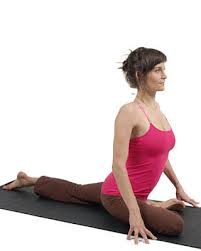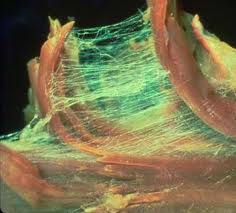Introduction
Yin and Yang
Yin Yoga is based on the Taoist concept of yin and yang, opposite and complementary principles in nature. Yin is the stable, unmoving, hidden aspect of an object, while Yang is its changing, moving, revealing aspect. These two objects always coexist, and everything in nature can be described in terms of its yin and yang.
All forms of yoga can be described as Yin or Yang based on which tissues of the body are being targeted. A practise that focuses on gentle traction and the stretching of ligaments, tendons and fascia (connective tissue) is Yin yoga and a practise that focuses on exercising and stressing the muscles is Yang yoga.
Read more…
The Myofascia
1. What is It
Fascia or myofascia is the dense, tough tissue which surrounds and covers all of your muscles and bones. This outer fascial covering is very strong and very flexible. In fact, it has a tensile strength of over 2000 pounds.
Under a microscope, myofascia resembles a spider web or fish net. It is very organized and very flexible in a healthy state.

Myofascia can best be described as a complete body suit which runs from the top of your head down to the bottom of your toes. It is continuous, has no beginning or end and can be found almost everywhere in your body. Like yarn in a sweater the entire body is connected to every other part of the body by the fascia. It is a continuous weave of material. And, like a pull in a sweater, damage to an area of fascia can affect other distant areas in your body even years later. Read more…
Good posture is important for your physical and emotional health. Good posture is defined as your head, neck, shoulders, hips and feet all in proper alignment relative to each other. When a person is viewed from the side, this means that the person stands tall with the head facing forward, with the neck over the shoulders and not protruding forward. The shoulders are back, not rounded and the hips are placed over the feet. There is no excessive roundness of the upper back (khyphosis) or excessive inward curvature of the lower back (lordosis). Viewed from the front, the persons head is straight and not tilted to the right or left, the shoulders are level as are the hips. The feet point straight ahead and are not rotated out or in.
 Good posture illustrated
Good posture illustrated
Read more…
In the general public there is much confusion about stretching. Common questions I hear are, is it necessary, am I too old, which muscles need to be stretched, how long do I stretch for, is dynamic stretching better than static stretching? In the professional world of physical fitness and athletics there is no such confusion. Stretching is necessary and should be an integral component of everyone’s exercise routine.
The benefits of stretching are far reaching and vitally important for men and ladies 50+ . The most important benefit is injury prevention. Gentle dynamic stretching in needed before you begin exercising to make sure your muscles are warmed up and loose and gentle static stretching after exercise is necessary to prevent soft tissue contracture and stiffness. Another important benefit of stretching is that it allows you to mentally prepare to exercise. This is especially important if you have had a busy day at work and had to rush to the gym, field or arena to exercise. Stretching allows you a few moments to regroup and refocus on your upcoming exercise routine, run, bike ride, walk or game. This way you are not only physically prepared but mentally prepared as well. After you exercise stretching allows you a few moments to relax and reflect on your exercise or game. It gives you an opportunity to cool down gently rather than abruptly. Read more…
One of the most overlooked components of fitness is flexibility. However, joint and muscle stiffness is one of the most common complaints of 50+ adults. A lack of flexibility compromises your ability to perform activities of daily living such as bending over, reaching, and getting out of chairs or cars. As well it compromises your ability to perform recreational sport activities such as golf, curling, biking, bowling, skating and hobbies such as gardening. Most significantly, a lack of flexibility leaves you very vulnerable to muscle and joint injury in your back, shoulders and legs.
Read more…




